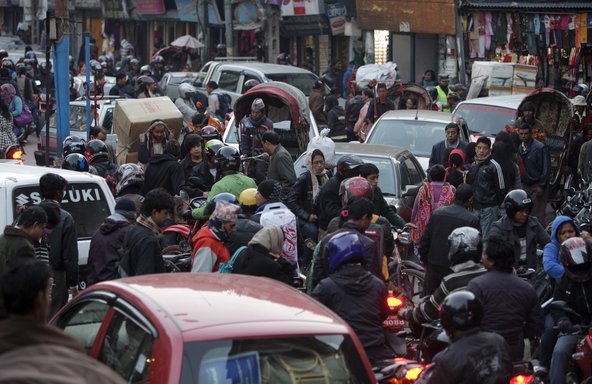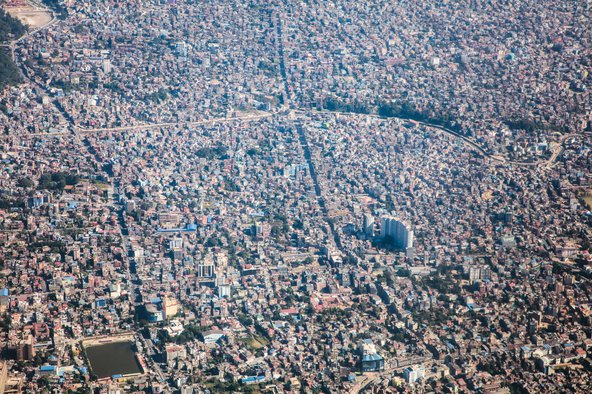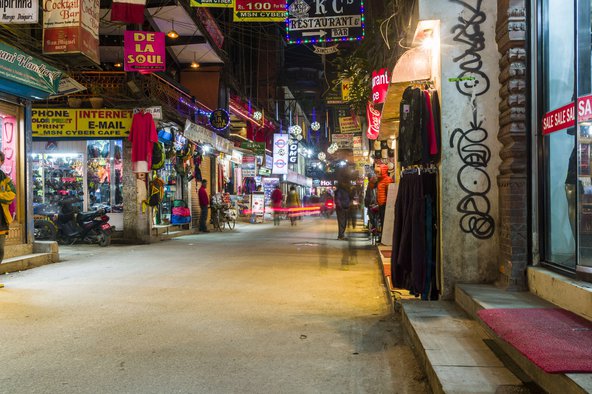Kathmandu’s 'improvised infrastructure in action'
by Professor Caroline Knowles
8 May 2018
‘Dear customer carrying television …’ read the sign at Kathmandu Tribhuvan International Airport. I didn’t realize quite how many passengers this sign addressed until I stood in line at the customs point while the televisions were duly examined. My flight had arrived from London via Doha, probably a good place to acquire what is evidently a luxury item (27% of the population owned one in 2006) . I later discovered that most people get their news and popular culture from the radio. As the technologies for circulating such things constitute an important piece of infrastructure, I count this as my first encounter with Nepalese infrastructure. This is significant for me as I was in Nepal in my capacity as the British Academy’s Director for Cities and Infrastructure programmes.
The British Academy research teams on the ground
The British Academy has two research teams in Nepal. One – led by John Twigg at the Overseas Development Institute – explores how people have recovered and rebuilt their lives since the 2015 earthquake. The other – led by Robin Coningham at Durham University – is about seismic safety and Kathmandu’s antiquities, a source of tourist revenue, as well as being of great historical significance. I was there to see how things were progressing.

A traffic jam in Kathmandu. Credit: Getty Images
Improvised infrastructure in action
My second encounter with infrastructure immediately followed the television line up. I jump into a dilapidated taxi and watch the city slip by through the window. The road from the airport to my hotel is strewn with rubbish. Much of it ends up in riverbeds. Cables are exposed. Pipes run along the surface of the road. Burying them is expensive. The roads are potholed and take it out the taxi floor. There are traffic jams because the roads are not wide enough and because there are not enough roads. Tangles of electrical wires overhead are diverted into homes and businesses. People live in ramshackle dwellings often made from corrugated iron and whatever else comes to hand. They make a living selling food and drinks and other small items. 70% of economically-active Nepalese operate in the informal economy. They make their own work and their own lives. This is improvised infrastructure in action.
Municipal authorities in Kathmandu struggle to provide basic infrastructure. In response, people stitch things together for themselves, and signs of this are visible all over the streets. Or so it seemed through the window of an ancient taxi driven at breakneck speed between traffic jams.

An aerial view of Kathmandu. Credit: Getty Images
Taking infrastructure for granted
A job that involves research on infrastructure is one thing, but experiencing it first hand as part of the daily life of my visit is quite another. While I had spent a great deal of time thinking about Kathmandu and infrastructure before I left London, I had spent no time at all thinking about it in more personal terms. I should have done.
Like others living in the global north, I take infrastructure for granted because it mostly works. But when infrastructures are fragile and don't work continuously, they become hyper-visible
Like others living in the cities of the global north, I take infrastructure for granted because it mostly works – light switches and taps mostly produce the desired outcome, and even Southern Rail will eventually get you from Brighton to London. Much infrastructure is invisible – hidden in pipes and cables beneath the ground – and most of us don’t think about wastewater or who picks up the rubbish. But when infrastructures are fragile and don’t work continuously, they become hyper-visible, as they had on my ride from the airport.
Help!
My thinking about infrastructure took a more personal turn when I arrived at the hotel, a beautiful old building close to the historic centre of the city with its enchanting ancient heritage buildings – infrastructures of the past. I am given a lovely room on the roof with a bathroom next door. I am assured there is broadband but I can’t make it work. The owner gives me a lesson. I must stand under the router on the third floor to log in, then I can go back to my room and it will work. Sometimes. I try to charge my dying phone battery. Only one electrical socket in my room works and it heats up alarmingly. In the night my phone just goes blank. I panic. My next day’s arrangements are stored inside. Without WhatsApp I am sunk. I decide to shower instead. The water works – mostly – and it’s cold. In contrast the staff are warm and helpful and fabulous.

A market street in Thamel at night. Credit: Getty Images
First World problems
First world problems is what my younger daughter says when I complain about anything. In the scheme of things, televisions and hotel facilities are rich people’s infrastructure problems. On the trip from the airport to my hotel, I glimpsed in passing some of the most significant issues that the people of Kathmandu live with on a daily basis and have learned to navigate –against which my own fleeting discomforts feel insignificant.
Professor Caroline Knowles BSc PhD is Professor of Sociology at Goldsmiths University of London and Director of the British Academy's Cities & Infrastructure Programme. Caroline writes about migration and circulations of material objects – some of the social forces constituting globalisation. She is particularly interested in cities, having done research in London, Hong Kong, Beijing, Fuzhou, Addis Ababa, Kuwait City and Seoul.


